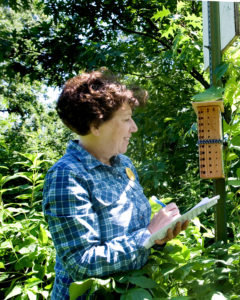By MARGIE O’LOUGHLIN
Every two weeks, Longfellow resident Kathy Swenson packs her data recording sheet, magnifying glass, and flashlight, and heads over to the Minnesota Bee Atlas test site at 36th St. and W. River Pkwy. Swenson is a volunteer monitor at one of two test sites in South Minneapolis; the other site is at the Nokomis Naturescape Garden on the northeast shore of Lake Nokomis.
Each site has what’s called a bee block on it: a chunk of wood with holes of different diameters that make channels for wild bees to lay their eggs in. The bee blocks were mounted on poles and put in place by Britt Forsberg, program coordinator for the University of Minnesota’s Extension Service, which is responsible for creating the bee atlas.
Careful monitoring of bee blocks across the state will provide new evidence as to which wild bees live where, and how they are doing.
 Photo left: Minnesota Bee Atlas monitor and Longfellow resident, Kathy Swenson, checked the bee block at 36th St. and W. River Pkwy. She said a lot of people who think they’ve been stung by bees have actually been stung by wasps. Wasps are smooth-skinned, carnivorous predators that live primarily on aphids, caterpillars, and other insects. Bees are hairy and live on pollen and nectar. (Photo by Margie O’Loughlin)
Photo left: Minnesota Bee Atlas monitor and Longfellow resident, Kathy Swenson, checked the bee block at 36th St. and W. River Pkwy. She said a lot of people who think they’ve been stung by bees have actually been stung by wasps. Wasps are smooth-skinned, carnivorous predators that live primarily on aphids, caterpillars, and other insects. Bees are hairy and live on pollen and nectar. (Photo by Margie O’Loughlin)
“I started monitoring the bee block in April,” Swenson said, “in-between blizzards. The first two times I went, all of the drilled holes in the bee block were empty. The third time I went, nine of the holes were filled, which meant that wild bees had laid eggs and deposited pollen sacs to nourish their young when they emerged.”
Forsberg, who is coordinating the making of the bee atlas, said, “This project is happening because the Extension Service received a four-year grant from the state’s Environmental and Natural Resources Trust Fund. We’ve engaged 150+ volunteers across the state to act as citizen scientists, gathering information about Minnesota’s wild bees through observation. Once completed, the online bee atlas will be hosted by the Bell Museum. Our goal is to have all of the data on wild bees in one place, where it can be accessible to the public as well as to researchers.”
The Prairie Oak Savannah and the Nokomis Naturescape Garden sites were chosen because they have a rich variety of native plants, which provide a variety of food sources for wild bees. Native plants rely on native pollinators; native bees need native plants to nest in and to eat.
Minnesota has an estimated 400 varieties of wild bees, and there are an estimated 20,000 varieties of wild bees worldwide.
Why should we care about wild bees? Forsberg said, “Wild bees are prolific pollinators, and are known to pollinate several types of plants that honeybees can’t. For instance, plants in the squash family can only be pollinated by a certain type of wild bee called the squash bee.”
She continued, “With all of the talk about colony collapse in the last several years, most of the media attention has been on honeybees. The factors that are threatening honeybees (climate change, habitat loss, and pesticides) are the same ones that are threatening wild bees. Our citizen scientists are adding to the existing data about wild bees that has already been collected by the DNR and the U of M Bee Lab.”
The site at 36th St. and W. River Pkwy. is focused on stem-nesting bees, which are bees that lay their eggs in plant stems. An easy way to attract stem-nesting wild bees in the home garden is this:
—plant native aster or cup plants;
—after they’ve bloomed in the fall, cut the stems off at 15- 18“; and
—let the stems stand over winter, and into the next spring.
New growth will soon be much taller than the old stems, which can provide nesting habitat for wild bees while remaining invisible.
Once all of the data has been compiled, the Minnesota Bee Atlas will help to answer questions about wild bee behavior from “where do wild bees live,” to “when are they most active?” Little is known about how wild bees are responding to the overgrowth of buckthorn in Minnesota forests—among other things. Information gathered from bee block sites may provide new insights into a changing environment.
Swenson, who is a retired National Park Service ranger and volunteer coordinator with the Mississippi National River and Recreation Area, said, “This is my first year as a site monitor, and I’ve enjoyed being part of a real research team. Citizen scientists don’t create or evaluate a scientific project, but they do contribute in meaningful ways.”
For more information, visit extension.umn.edu/natural-resources-volunteers/minnesota-bee-atlas.
Comments
No comments on this item Please log in to comment by clicking here